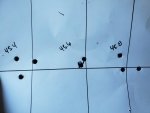I'm not sure how into the weeds everyone gets with reloading. That said, this week me and a friend were contemplating reloading and our different positions on it. Also, if this thread is better in another area, let me know so I can delete it and move it there.
He prefers a lower speed accuracy node because it is more accurate and arguably easier to tune. I prefer a higher speed accuracy node because I shoot 308, and I want to run as fast as possible to cheat wind at least in my eyes.
When contemplating these two different positions, I wondered why the higher speed node is narrower and more picky. Is it because barrel harmonics? IE, the barrel vibration is higher frequency or something like that.
The reason he and I were discussing this was because I recently was doing an OCW test. During that test, in my higher speed load, I went from 45.4gr and about a 1moa group to 45.6gr and less than .5 moa, back to 1 moa at 45.8gr. I was hypothesizing that the. barrel is vibrating faster which allows for less of a node... either that or my group and results were complete luck, which is also 100% possible.
What do you guys think? This is just for hypothetical or academic purposes on the subject.
He prefers a lower speed accuracy node because it is more accurate and arguably easier to tune. I prefer a higher speed accuracy node because I shoot 308, and I want to run as fast as possible to cheat wind at least in my eyes.
When contemplating these two different positions, I wondered why the higher speed node is narrower and more picky. Is it because barrel harmonics? IE, the barrel vibration is higher frequency or something like that.
The reason he and I were discussing this was because I recently was doing an OCW test. During that test, in my higher speed load, I went from 45.4gr and about a 1moa group to 45.6gr and less than .5 moa, back to 1 moa at 45.8gr. I was hypothesizing that the. barrel is vibrating faster which allows for less of a node... either that or my group and results were complete luck, which is also 100% possible.
What do you guys think? This is just for hypothetical or academic purposes on the subject.
Attachments
Last edited:


